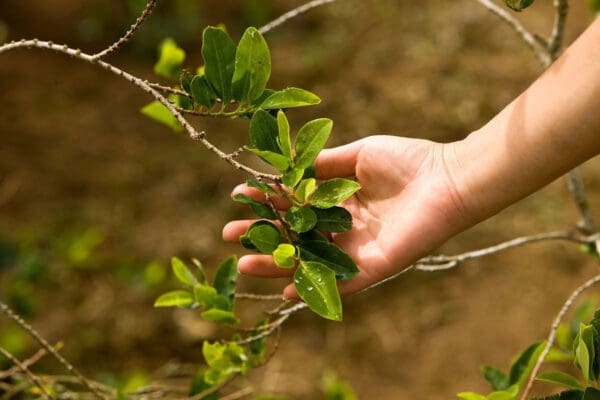
Active Placebo
A substance used in controlled drug trials that has no medical or therapeutic effect on the condition being studied, but tricks the volunteer into thinking they have received the psychoactive drug. In trials studying psilocybin, researchers have used niacin and methylphenidate (Ritalin) as active placebos.
The difference between an active placebo and a regular inactive placebo is that the active placebo produces side effects that may make the volunteer think they have received the regular drug being tested.
Ayahuasca
Ayahuasca is a psychedelic tea made from plants native to the Amazon basin typically Banisteriopsis caapi and Psychotria viridis (or chacruna). Ayahuasca is used sacramentally by indigenous peoples of South America. The chacruna plant contains DMT (N,N-dimethyltryptamine), which is a psychedelic compound. It must be ingested with a monoamine oxidase inhibitor such as Banisteriopsis, otherwise it becomes deactivated by our digestive enzymes.
Ayahuasca can be prepared in many different ways, but it’s most commonly brewed as a hallucinogen that induces intense visions or hallucinations. When consumed with care, ayahuasca offers shamanistic healing rituals and spiritual guidance for those who take part in these sacred ceremonies.
The Beckley Foundation
The Beckley Foundation was established in 1998 to support psychedelic advocacy and research with the aim of reforming drug laws internationally. The organization was founded by Amanda Feilding in England and is named for her ancestral estate in Oxfordshire.
The Beckley Foundation is at the forefront of drug reform and uses evidence-based research into psychoactive substances to advocate for global policy initiatives. Their purpose is to scientifically investigate how psychoactive substances interact with our brains and use this information to discover new avenues for the treatment of illnesses.
Council on Spiritual Practices (CSP)
The Council on Spiritual Practices works to “identify and develop approaches to primary religious experience that can be used safely and effectively.” This nonprofit organization was founded by Bob Jesse in 1993 and has funded and supported research and legislation to advocate for psychedelic research.
Since its founding, CSP has worked to organize and develop conferences and meetings with scholars from prestigious research centers and universities including Johns Hopkins University, the University of California at Berkeley, Los Angeles and San Francisco, and more.
Default mode network (DMN)
The default mode network is a network of brain regions that is most active when your brain is in a resting state, or when a person is not focused on the outside world. Neuroimaging studies show that the DMN is involved in higher-order activities like self-reflection. Neuroimaging studies also show that the DMN is involved in metacognitive activities such as mental projection, time travel, and theory of mind. Activity in the DMN decreases during psychedelic experiences, and people often report feeling a lost sense of self.
DMT (or N,N-Dimethyltryptamine)
DMT is a hallucinogenic drug that produces similar effects to other psychedelics such as LSD or psilocybin. In the United States, DMT is a Schedule 1 drug and is currently illegal. It occurs naturally in many plant species found in South American countries, and has been used in religious ceremonies for centuries. DMT is the main active ingredient in ayahuasca.
Empathogen
Empathogens refers to a category of drugs, including MDMA, that produce heightened senses of empathy and compassion toward others. Also referred to as entactogens, they release dopamine and serotonin in the brain, which control mood, appetite and sleep.
Entheogen
Entheogens are psychoactive substances derived from plants or fungi that produce spiritual experiences. Entheogens perception, mood, and consciousness, and have been used for religious or spiritual practices in various cultures for thousands of years. The term was first used in the 1970s by a group of scholars studying substances like psilocybin, DMT, and cannabis.
Esalen, or the Esalen Institute
The Esalen Institute is a non-profit holistic learning and retreat center located on 120 acres of land in Big Sur, California. The Esalen Center for Theory & Research (CTR) focuses on humanistic alternative education.
The Esalen Institute had close ties to the psychedelic movement before the drugs were banned, and now serves as a place for psychedelic guides to receive underground training in alternative medicine.
5-HT2A receptor
The 5-HT2A receptor belongs to the serotonin receptor family. Psychedelic drugs bind to this receptor, which triggers a series of events that produce the psychedelic experience. 5-HT2A has a distinctive shape that makes it able to bind well to LSD and may explain the longevity and intensity of a LSD trip.
5-MeO-DMT (5-methoxy-N,N-dimethyltryptamine)
5-MeO-DMT is a psychedelic compound that is found in a wide variety of plant species and also in the Sonoran Desert Toad. It has been used as an entheogen in South American cultures and is said to have anti-anxiety and antidepressant effects. It’s most common form of ingestion is through smoking.
Hallucinogen
Hallucinogens are a group of drugs that alter a person’s perceptions, thoughts and feelings. They are commonly split into two categories: classic hallucinogens and dissociative drugs. Psychedelics such as LSD, psilocybin and peyote are considered classic hallucinogens. Ketamine is an example of a dissociative drug. Some hallucinogens, like peyote, are naturally derived; others, such as LSD, are synthetic.
Harvard Psilocybin Project
Timothy Leary and Richard Alpert established the series of experiments called the Harvard Psilocybin Project in 1960. Leary and Alpert believed that psilocybin could be used as a solution to emotional problems and conducted experiments with psilocybin to volunteers in a “naturalistic setting,” as well as at Concord State Prison. They also researched and experimented with LSD before the project was shut down in 1962 when it came under controversy for violating its agreement with Harvard by administering psilocybin to an undergraduate.
Heffter Research Institute
The Heffter Research Institute was established in 1993 and supports research around psychedelic compounds. Named after Artur Heffter, a German chemist who first identified mescaline as the psychoactive component of peyote, the Hefftner Institute has played a pivotal role in advancing the studies of psilocybin for the treatment of addiction and other mental health disorders. The Hefftner Research Institute has helped to fund most of the psilocybin trials that have been done in America in recent decades.
Holotropic Breathwork
Holotropic Breathwork is a breathing technique where one breathes rapidly and exhales deeply (almost like hyperventilation) to enter an altered state of consciousness without the use of drugs. This breathing exercise was developed by a psychedelic therapist named Stanislav Grof after LSD was outlawed. The idea behind holotropic breathwork is that it is supposed to induce a trancelike state that will give access to the subconscious mind.
LSD (lysergic acid diethylamide)
LSD is a psychedelic compound derived from ergot, a fungus found in grains. It was first synthesized in 1938 by Swiss chemist Albert Hofmann, who accidentally discovered its psychedelic properties in 1947 when he accidentally ingested a small amount of LSD on what is now famously known as “Bicycle Day.” LSD has been used in many different ways: as a recreational drug, and for therapeutic purposes. Clinical research has shown that this potent psychedelic substance can be highly effective when treating alcohol addictions or opiate dependence.
MAPS (Multidisciplinary Association for Psychedelic Studies)
MAPS is a non-profit organization dedicated to increasing the public understanding and support of psychedelic research and the use of psychedelics for therapeutic purposes. MAPS focused their efforts on promoting the use of MDMA (Ecstacy) and psychedelic-assisted therapy for the treatment of PTSD. In 2016 MDMA received FDA approval for Phase 3 trials in the treatment of PTSD, and in 2017 it was designated as a “breakthrough therapy.” MAPS has played a vital role in the revival of psychedelic research in recent decades.
MDMA (3,4-methylenedioxymethamphetamine)
MDMA is a synthetic, psychoactive substance best known for producing a euphoric state with simultaneous stimulant and psychedelic effects. It’s effects are produced by increasing the levels of serotonin, dopamine and norepinephrine in the brain. It was first synthesized in 1912 by German chemists attempting to remedy blood loss. In the 1970s it became a popular adjunct to psychotherapy because of its empathogenic qualities that help patients open up and form a bond with their therapists.
MDMA (also known as Ecstacy or Molly) is a Schedule 1 drug in the United States, but recent drug trials and ongoing research have shown promise in its ability to treat symptoms of PTSD.
Mescaline
Mescaline is a naturally occurring psychedelic compound that can be found in several species of cacti, including peyote and San Pedro. It has hallucinogenic effects similar to that of LSD and psilocybin, and has been used in religious ceremonies for thousands of years. Mescaline was first identified by German chemist Arthur Heffter in 1897.
Microdosing
For those who want to experience the therapeutic effects of psychedelics but don’t want to feel the hallucinogenic effects, microdosing is an option. It is the practice of taking small, sub perceptual doses of a drug every few days. It is becoming increasingly popular as a method to treat anxiety and depression and to increase productivity and creativity. LSD and psilocybin are popular psychedelics for microdosing.
MK-Ultra
MK-Ultra was the code name used for an undercover research program by the CIA in the 1950s to explore the effects of psychedelic drugs. The goal of the program was to determine if LSD and other similar drugs could be used for mind control or as a means of interrogation or as a biological weapon. During the program, both civilians and military personnel were given LSD without their knowledge or consent. This program was shut down in 1963, but the public did not find out about it until Church Committee hearings in 1975.
Mystical Experience Questionnaire
Walter Pahnke and William Richards developed the Mystical Experience Questionnaire in the 1960s to assess whether volunteers in a psychedelic drug trial had experienced a mystical experience. The questionnaire measured seven attributes of a mystical experience on a scale of 1-5: internal unity; external unity; transcendence of time and space; ineffability and paradoxicality; a sense of sacredness; the noetic quality; and a deeply positive mood.
Noetic quality
Noetic quality is the term used to describe a state of knowledge experienced in a mystical state. The term was introduced by American psychologist William James to describe the knowledge and important truths that were reportedly revealed to people during mystical experiences.
Phenethylamines
Phenethylamines are organic compounds which act as central nervous system stimulants in humans. They are one of the two main types of psychedelic compounds.
Psilocin
Psilocin, along with psilocybin, are psychoactive compounds that are found in most psychedelic mushrooms. Both psilocin and psilocybin were first isolated in 1958 by Swiss chemist Albert Hofmann.
Psilocybe
Psilocybe is a genus of gilled mushrooms in the Hymenogastraceae family. They grow all over the world and most contain the psychedelic compounds psilocin, psilocybin and baeocystin. They are typically small, nondescript mushrooms with a brown-to-yellow color. Th
Psilocybin
Psilocybin is a naturally occurring psychedelic compound found in psychedelic mushrooms. It’s psychedelic effects include euphoria, hallucinations, and changes in perception and time. Psilocybin containing mushrooms have been used for both spiritual and medicinal purposes.
Psychedelic
The term refers to hallucinogenic drugs that trigger non-ordinary states of consciousness. The term originates from the Greek words psyche (“soul, mind”) and deloun (“to manifest”) and was coined in 1956 by Humphrey Osmond, a British psychiatrist, to describe drugs like LSD and psilocybin that produce an altered state of consciousness.
Psycholytic Therapy
A type of therapy that uses light doses of psychedelics at regular intervals to expand the power of the heart and mind to deepen the power of psychotherapy sessions. It is similar to psychedelic therapy, but differs in that it uses low doses of psychedelic drugs over time, rather than one or two powerful doses. Unlike powerful psychedelic experiences, the use of psycholytic therapy allows the patient to retain more control of their thoughts and emotions while still feeling the effects of the drug.
Psychotomimetic
Refers to drugs that produce effects similar to psychosis, including delusions or delirium, rather than just hallucinations. When drugs like LSD were first introduced into the world of psychiatry in the 1950s, researchers believed that they produced temporary psychosis.
Set and setting
The terms set and setting refer to the environment in which a person experiences a psychedelic trip. “Set” refers to a person’s mindset and experiences, both short-term and long-term, including past traumas or experiences that may have taken place. “Setting” refers to the physical environment in which the trip takes place, such as outdoors in nature or in one’s home. These two factors can have a great impact on the psychedelic experience.
Tryptamine
A naturally occurring organic molecule that is one of the two principal types of psychedelic compounds. It regulates the activity of the dopaminergic, serotonergic, and glutamatergic systems. LSD, psilocybin, and DMT are tryptamines.






